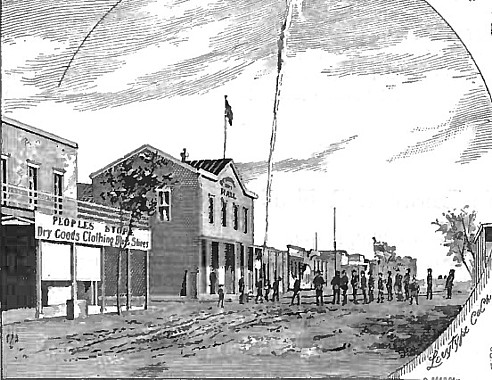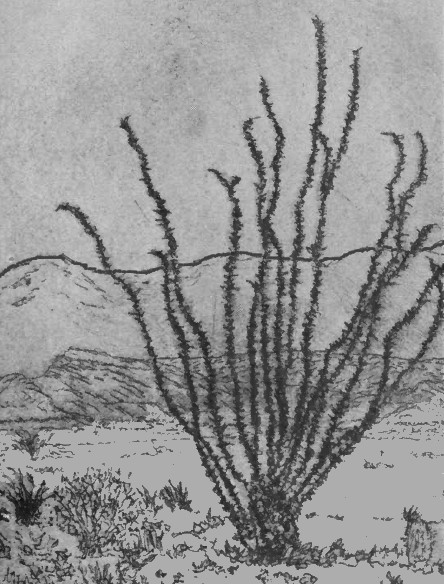Maynaud District.—This district is in the Hualapai mountains, twenty-eight miles east of Mineral Park. It is the finest wooded portion of Mohave, and is producing 'some very rich ore. The Atlantic and Pacific railroad will pass within ten miles of the mines. The American Flag is the leading mine of the district. It is a 2-foot vein of sulfide ore, giving an average assay of $100 per ton. It is thoroughly opened by 2,000 feet of shafts and drifts. Some of the richest ore ever taken out in the Territory has come from this claim. It has produced $70,000, the ore being shipped to San Francisco. A mill will shortly be erected. The Antelope shows a 4-foot vein of fine sulfide ore. It is opened by 400 feet of shafts and drifts. The mine has produced $15,000. The Dean has a large vein, nearly 6 feet in width. It has a shaft 180 feet, and 600 feet of tunnels. The ore is a sulfide and of a high grade. The Mariposa is opened by 700 feet of shafts and drifts. It carries good ore and has yielded nearly $8,000.
Cedar Valley: The Cedar Valley District is about sixty miles east of the Colorado river at Aubrey Landing, and about sixty miles south of Mineral Park. "Wood is abundant, and water for ore reduction can be had at the Sandy, fifteen miles distant. The veins are well defined, in walls of granite. The ore is argentite, a sulfide of silver. The Arnold shows a vein 18 inches wide, that assays $100 per ton. It has a shaft 60 feet, and a tunnel 130 feet. It is owned by the Arnold Mining Company, and has produced $20,000, gold and silver. The Silver Queen has a shaft 130 feet, and over 200 feet of tunnels and cross-cuts. Its vein is 3 feet, assaying $60 per ton. A 5-stamp mill and roaster have been erected on the property by the Hampden Mining Company. The Hibernia is a strong vein, 4 feet wide, with an average of $60 per ton. It has a shaft 100 feet. The Hope is a large vein and has some very rich ore. It is estimated that it has yielded $20,000. The Bunker Hill is a 2-foot vein, and the Congress is a vein of the same size, both carrying good ore. These are only a few of the mines of Cedar Valley. There are scores of others, well worthy of inspection.
Hackberry District.—This camp is about 30 miles east of Mineral Park, in the Peacock range. The formation is a granite and porphyry. The camp was at one time the most prosperous in Mohave, but the stoppage of the Hackberry mine has caused it to become almost deserted. It is expected that with the advance of the Atlantic and Pacific railroad, which will pass within three miles of the mines, operations will again be resumed. The Hackberry vein is about 40 feet in width. About 18 inches of this vein carries rich silver ore, which gives an average, by working process, of $200 per ton. There is one shaft of 400 feet, another of 270, and one of 180 feet. The mine is opened by levels, drifts, and cross-cuts. It is estimated that the total yield of bullion has been over $300,000. A fine 10-stamp mill and roaster have been erected on the property. The mine is owned by the Hackberry Milling and Mining Company. The Descent is a small vein of rich ore, which has produced nearly $30,000. It has two shafts, one of 90, and one of 100 feet. The Hester is an extension of the Hackberry. It has two shafts, 100 and 60 feet each. It has produced about $10,000. The Hackberry South is a 4-foot vein, assaying $50 per ton. It is opened by several shafts, and has yielded $15,000.
San Francisco: This District is situated nine miles east of Hardyville on the Colorado river, in the Union Pass range. It was discovered in 1863, and work has been carried on there at intervals ever since. The Moss is the leading mine of the district. It is an immense ledge of gold ore, nearly 40 feet in width, and will average $12 per ton, from wall to wall. The mine has been worked extensively in years past, and has produced some of the richest native gold rock ever taken out in the Territory. It has one tunnel 290 feet, one shaft 240 feet, one shaft 98, and 1,700 feet of levels, drifts, etc. The mine has produced nearly $130,000. Its proximity to the river makes this a valuable project for those who have the requisite capital to work it properly. The San Francisco Moss is an extension of the Moss. It is a vein 40 feet in width, carrying ore that averages all the way across, $6 per ton. There are many portions of the ledge that go much higher. It has 300 feet of shafts, drifts, and tunnels. The West Extension is an 18-foot ledge of gold quartz, with a 60-foot shaft.
Gold Basin – This District has just been organized, and is situated thirty-five miles north from Mineral Park, in the Cerbat range. The ledges are large gold-bearing quartz dikes. The El Dorado has a vein from 2 to 4 feet wide, that assays $40 per ton. The Northern Belle shows 2 feet that will assay $25 per ton. The Golden Eule is a vein about one foot wide, assaying $70 per ton. The Poorman has a foot of ore worth $60 per ton. The Indian Boy, Harmonica, K, Antelope, Buckskin, and Banker, are all very fine-looking prospects, assaying from $15 to $100 per ton, in gold.
Owens District – This mining area is in the southern portion of Mohave, near the line of Yuma. The formation of the country rock is granite and porphyry. Abundance of water is found in the Sandy, which flows through the district. The camp was established in the fall of 1874, and has been the most productive portion of Mohave county. The fame of the McCracken has extended all over the coast. The heavy cost of supplies of all kinds has caused the temporary stoppage of work on this property, but with the advent of the Atlantic and Pacific railroad, which will pass within forty miles of the mines, work will no doubt be resumed. The Alta and the Senator are the leading mines of the district. They are on the great McCracken lode, which cuts across the country for miles. .They show veins of free-milling ore, from 6 to 37 feet in width, which have worked $35 per ton. Over $200,000 has been expended in work and in improvements, and more than $800,000 in silver has been taken out. They are owned by the McCracken Consolidated Mining Company. Two mills have been erected, one of 20 stamps and one of 10 stamps. The ores of this great fissure are mainly horn silver chlorides, bromides, sulfides of silver, with some galena. Over 24,000 tons of ore have been extracted and worked. The mines are opened by a shaft 367 feet deep, sunk on the line between them, and by five adit levels run on the vein. In size of vein and free character of its ores, the McCracken has few equals in the Territory. The San Francisco and the Atlanta are north of the Senator and Alta, on the same vein. They are owned by the Peabody Mining Company, and have produced nearly $200,000. They show about 30 feet of chloride ore, with some galena that has averaged $30 per ton. The San Francisco has a shaft 300 feet, and over 300 feet of tunnels and drifts. The shaft of the Atlanta is down 150 feet. It has also a tunnel 200 feet in length. Work is carried on steadily. The Centennial and the Potts mine are about four miles south of the Senator, on the same vein, have had considerable work done on them, and show largo ore bodies.
Greenwood District – This adjoins Owens district on the east. Its principal mine is the Burro, situated on a creek of the same name. It is one of the largest veins in the Territory. It shows 35 feet of ore going from $8 to $300 per ton. A shaft has been sunk 250 feet, and several cross-cuts made on the claim. It carries gold and silver, and has abundance of wood and water close at hand.
Return
to The Arizona Page:
Arizona Gold Rush Mining History



